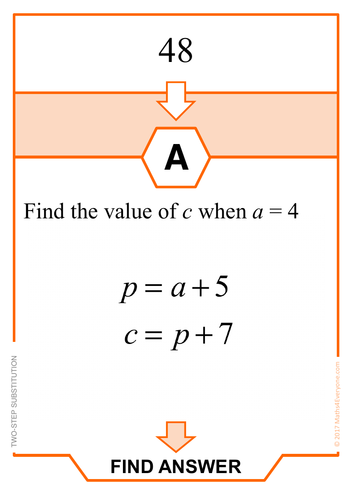




This activity is based on a question which I saw within the White Rose Maths Scheme. It gives students plenty of practice at substituting numbers into simple formulae.
Click 👉https://tes.com/.../more… for similar style Treasure Hunts on more than 40 other topics.
--
Note that unlike most Treasure Hunts, this one has the added feature that the answers give an encrypted clue. Deciphering this clue reveals where the treasure is hidden!
A Treasure Hunt is a great activity which children love. They are ideal for revision, starters or plenaries. They are a really great way to get students to answer questions quickly and enjoy doing so.
These question cards have been prepared in two sizes. The large cards can be pinned around the classroom and used for a whole class activity; the smaller (loop cards) can be used for group work or by individuals ��� they are particularly helpful for one-to-one tutorials and during interventions.
Colour coding:
I have used colours to indicate the approximate level of the questions:
KS2 – red and orange
KS3/GCSE Foundation – orange and green
GCSE Higher – green, blue and purple
👍If you like this resource, then please rate it and/or leave a comment💬.
If the rate-resource button on this page does not work, then go to your ratings page by clicking here 👉 https://tes.com/.../rate-resources…
Click 👉https://tes.com/.../more… for similar style Treasure Hunts on more than 40 other topics.
--
Note that unlike most Treasure Hunts, this one has the added feature that the answers give an encrypted clue. Deciphering this clue reveals where the treasure is hidden!
A Treasure Hunt is a great activity which children love. They are ideal for revision, starters or plenaries. They are a really great way to get students to answer questions quickly and enjoy doing so.
These question cards have been prepared in two sizes. The large cards can be pinned around the classroom and used for a whole class activity; the smaller (loop cards) can be used for group work or by individuals ��� they are particularly helpful for one-to-one tutorials and during interventions.
Colour coding:
I have used colours to indicate the approximate level of the questions:
KS2 – red and orange
KS3/GCSE Foundation – orange and green
GCSE Higher – green, blue and purple
👍If you like this resource, then please rate it and/or leave a comment💬.
If the rate-resource button on this page does not work, then go to your ratings page by clicking here 👉 https://tes.com/.../rate-resources…
Something went wrong, please try again later.
thanks!
Another great resource from you. Thank you for your hard work!
Thanks for sharing.
Report this resourceto let us know if it violates our terms and conditions.
Our customer service team will review your report and will be in touch.
£0.00